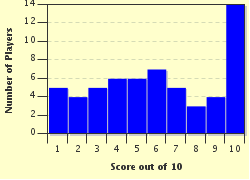Quiz Answer Key and Fun Facts
1. In the key of A major, which three notes are to be played or sung sharp (unless a natural or flat symbol is placed next to the notes)?
2. Most of the notes written in music for a bass singer tend to be around E in the second octave (E2) to E in the fourth octave (E4). What is the term for the comfortable range of a singer and where most of the notes fall?
3. The four strings on a bass guitar, when played individually, contain the notes E, A, D, and G in ascending order. What is the interval from the second to the fourth string (A to G) if the notes are also played in ascending order?
4. Suppose a piece of music is written in the time signature of 9/8. Which durations of notes (without any rests added) CANNOT be written in one measure?
5. We see 4 sharps in the key signature of a piece of music, and, instead of E major (based on the note E), the scale is based on the note C# (sharp). Which mode, also known as natural minor, are we in?
6. If we play all the notes in the scale of B-flat major, with no extra sharps or flats in between (B-flat, C, D, E-flat, F, G, A, B-flat), then what type of scale is this considered?
7. Which chord contains the notes G, B-flat, and E-flat in that exact order and played simultaneously?
8. In the key of D major, C# is which scale degree relative to D?
9. If a song was written at a tempo of 126 beats per minute, what tempo would this be classified as?
10. Which musical symbol, which looks like a semi-circle with a circle underneath it, means to hold a note longer than its written duration?
Source: Author
3Xy147Bm
This quiz was reviewed by FunTrivia editor
ertrum before going online.
Any errors found in FunTrivia content are routinely corrected through our feedback system.

